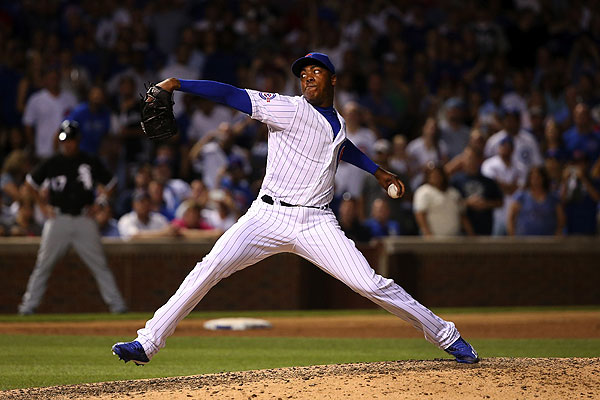A while back I looked at the considerable price the Cubs paid for Aroldis Chapman, in the context of his performance in the highest-leverage situations. Compared to another elite closer with similar stats but a totally different skill set, the comparatively slow-throwing Mark Melancon, Chapman's unprecedented velocity does give him an advantage. Speed means keeping the ball out of play, which means avoiding sac flies or errors, which could prove critical in short playoff series.
I was reminded of this by a tweet from Daren Willman, director of baseball R&D at MLB.com.
Aroldis Chapman's average fastball velocity this year is 100.7 MPH… Highest of his career.
— Daren Willman (@darenw) August 26, 2016
How does he do it? There's a great explanation from Tom House, one of the greatest pitching coaches of all time. He's got the perfect body for it, and the elements of his delivery that generate velocity are all at the extremes of a pitcher's ability.
One caveat, though. House says that you "may be looking at the hardest-throwing individual that's ever been on this planet." That's almost certainly true in a larger sense, in that Chapman consistently throws harder than anyone else.
But he's aided somewhat in that he's a reliever; he doesn't have to mix speeds or conserve his arm like a starter. And there's some controversy as to whether Nolan Ryan actually threw a pitch faster than Chapman's generally acknowledged record of 105.1 miles per hour.
It comes from a Carnegie Mellon physicist named Gregg Franklin, in an enjoyable documentary called Fastball, about the greatest practitioners of the craft of throwing really hard, and our ever-evolving measurements of their pitches. For years Ryan held the official record of 100.8 miles per hour, a speed that seems pedestrian when Chapman nearly averages that. But there's a catch. Ryan's pitch was measured after it had about 40 feet to slow down.
The aforementioned Ryan, the all-time strikeout king (by a lot) with 5,714, became the first pitcher to have his fastball measured in an actual game by radar back in 1974. “The device was set up to measure his pitching speed about 10 feet in front of home plate,” physicist Franklin explains. “And he was actually clocked at 100.8 miles per hour.” Not in Chapman's league. Because it's probably better.
I did not know until I saw Fastball that in recent years pitch speed is measured 50 feet from home plate…. That's where Chapman hit 105.1. Franklin… estimates that when Ryan's 1974 pitch was 50 feet from home it was traveling at better than 108 mph. “So we believe that once we make corrections,” Franklin says, “this is really the fastest pitch recorded.”
Of course, as House points out in the video, Chapman's release point means that a batter would perceive a 105 mph pitch from Chapman as around 108 mph, because it's released a foot closer to the batter than with the typical pitcher. And there's little argument that Chapman throws harder than anyone else in a general sense; in one night earlier this year when he was still with the Yankees, Chapman threw five of the six fastest pitches ever measured by Statcast. But the fastest pitch ever thrown is up for debate—and it's a little lesson in how technology and the way we use it changes what we perceive as the cold hard numbers.



